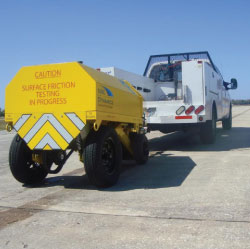
The goal of measuring a runway with CFME is to obtain data for scheduling remedial work on the runway surface. The FAA is changing its focus away from maintenance testing and towards the ICAO designations of good/medium/poor/nil runway condition assessments.
ICAO’s International Friction Task Force – whose members include aerodromes, manufacturers, regulators and other air transport stakeholders – is currently engaged in its fifth meeting to help establish and identify where friction standards can be improved. The Task Force is expected to produce a circular for ICAO committees before the end of this year with a three-pronged approach: to establish a benchmark where changes need to be implemented, recommend changes and best practices and draw up an action plan for implementation.
Currently, friction testing measurements on the runway lack a uniform standard. JAR-OPS 1 produced by the Joint Aviation Authorities (JAA) regulation currently specifies that it is essential the surface of a paved runway provides good friction characteristics when the runway is wet. However, the complexity arises where the rule states: “a dry runway includes paved runways which have been specially prepared with grooves or porous pavement.”
This assumption that if a runway is ungrooved then it isn’t right, is a myth, explained Paul Fraser-Bennison, Aerodrome Standards, CAA. “British runways have tended to be grooved, which improves texture and depth, but there are limitations for grooved Marshall Asphalt. EU-OPS 1 ignores other skid resistant surfaces. There are other tried and tested asphalts available that give adequate texture results, without treatment.”
Harmonisation is a key priority for the Friction Task Force, he said. “The way forward is if we could move towards a classification system – rating runways on their friction performance – including some kind of quantifiable figure of texture and depth. The question is what are we trying to achieve, not what material is used to give the best performance for a cost effective, compliant runway.”
Currently, commercial aircraft can land and take off from an ungrooved asphalt runway anywhere in Europe, but in the UK, they cannot land on the same material if it is ungrooved. The unlevel playing field is made more apparent where runway surfacing materials are beginning to emerge at UK airfields which have shown the equivalent or greater friction characteristics than conventional Marshall Asphalt. Jersey is among the first UK airports to choose BBA (Bétons Bitumineux pour chaussées Aéronautique) to resurface its runway and is reporting excellent friction readings.
TALPA ARC: The FAA’s Rulemaking Committee
The FAA’s impetus to research on friction testing has come from the FAA’s Office of Airports Friction programme, which has consisted of developing Continuous Friction Measuring Equipment (CFME) performance standards, as well as sponsoring annual CFME tests, typically held at NASA’s Wallops Island Flight Facility in Virginia. Annual trials at the flight facility have involved inviting airports and organisations to bring their friction and surface testing machines, which have been tested on different runway surfaces against a set of known values. Data collected shows the diverse friction values reported from each device, with an emphasis on the need to develop standardised testing procedures.
While the programme was designed to develop standards for equipment producing runway friction values that would be used for runway maintenance purposes, there is a new agency focus towards the FAA Takeoff/Landing Performance Assessment Aviation Rulemaking Committee (TALPA ARC), which was formed in February 2008 as an industry response to an incident where Southwest Airlines was involved in an overrun incident.
The goal of TALPA ARC is to standardise condition reporting: to move away from determining maintenance levels for use at airports and towards the ICAO designations of good/medium/poor/nil runway condition assessments and therefore an operational focus. The concept involves using a Paved Runway Condition Assessment table as the basis for runway condition reporting by airport operators and pilots. This is based on aircraft performance data supplied by aircraft manufacturers for each stated contaminant, type and depth.
The matrix has only been tested at a few airports during the winter 08-09 period and recommendations have been made that a more extensive pilot programme should be conducted this winter. Guidance also needs to be developed for pilot training in ensuring a consistent approach is taken when using the matrix.
The International Friction Task Force is in the process of discussing progress and further recommendations. These procedures would be published in AIM and aircraft flight operations manuals and the findings of TALPA ARC may also result in revisions to the FAA Advisory Circulars on winter operations (AC 150/5200-30) and the measurement, construction, and maintenance of skid-resistant airport pavement surfaces (AC 150/5320-12).









